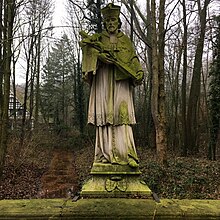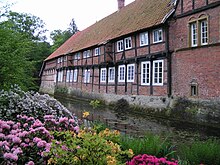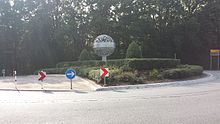Dinklage Castle Monastery

Klosterburg Dinklage ( Abbey of St. Scholastica ) is the name of an abbey of Benedictine nuns . This is housed in the rooms of Dinklage Castle in Dinklage , Vechta district , in the Oldenburger Münsterland (Lower Saxony).
The abbey is named after Saint Scholastica , sister of Saint Benedict of Nursia . The monastery is located in Dinklage Castle, a moated castle owned by the Westphalian noble family von Galen . The future bishop and cardinal of Munster Clemens August Graf von Galen (1878–1946) was born in the castle. He was born on October 9, 2005 by Pope Benedict XVI. was beatified .
The castle has been part of the "Burg Dinklage" protected landscape area since 1983 . The Burgwald Dinklage nature reserve , in which the castle is embedded, was removed from this in 2017 .
history
In December 2009 the Cardinal von Galen Foundation Burg Dinklage was founded. The foundation, initially provided with a share capital of 50,000 euros, is primarily intended to serve as a place of remembrance, remembrance and inspiration at Dinklage Castle with the buildings of the castle chapel, the old water mill (the forester's house) and the so-called bakery - the "cardinal triangle" - to create and operate.
History of the castle
The first castle complex in Dinklage was Ferdinandsburg, first mentioned in a document in 980, seat of the Counts of Dersagau . It was built around 500 meters east of the facility that still exists today. In 1231 the Ferdinandsburg became the property of the family of Johann von Dinklage , a former administrator in the service of the counts. The Ferdinandsburg was razed in 1374 by the Prince-Bishop of Münster .
In 1394, the prince-bishop enfeoffed the four living sons of Friedrich von Dinklage with all of Dinklage and Vechta. The rebuilding of the Ferdinandsburg was forbidden, but they built four new castles in its vicinity, three of which are identified by name: the Herbordsburg (where the Alte Rentei, built in 1677 today is located), the Hugoburg (which was demolished in 1840) In their place stands the count's castle chapel) and Dietrichsburg, today's Dinklage moated castle.
In 1588, the Dietrichsburg was inherited by the von Ledebur family ; the Hugoburg and the Herbordsburg remained in the possession of the von Dinklage family. Hugo Arnold von Dinklage, the last of his name in Dinklage, sold the two castles in 1667 to the Baron von Galen . In 1775 the Ledebur family also received ownership of the Dietrichsburg, which in 1801 also sold the property to the von Galen family. Heinrich von Galen, Drost of the Office in Vechta, had already leased the Dietrichsburg in 1641 and took up residence there. The Dietrichsburg became the ancestral seat of the von Galen family in the Oldenburger Münsterland, which was raised to the rank of count in 1803.
In 1677, the prince-bishop established the imperial-free glory of Dinklage (abolished in 1827) from the feudal estates and the parish of Dinklage and transferred it to the von Galen family.
Count Ferdinand von Galen (1803–1881), known as a member of the Reichstag , and his son Friedrich Mathias (1865–1918) were the last owners to live in Dinklage Castle. Until 1928, Franz von Galen (1879–1961), a brother of Friedrich Mathias and of the later Cardinal Clemens August von Galen, administered the Dinklager possessions for the heir Christoph Bernhard Graf von Galen (1907–2002). In 1949, Count Christoph Bernhard transferred ownership of the castle to the Benedictine nuns named below.
History of the monastery
1941 to 1945
From 1941 to 1945, Benedictine nuns from the Vinnenberg monastery in Warendorf (North Rhine-Westphalia), who had been expelled from their monastery by the National Socialists, were housed in Dinklage Castle. They returned to Warendorf in 1945 after the end of World War II .
Since 1949
When Benedictine nuns from the Alexanderdorf monastery in Alexanderdorf (then Teltow district ), which was occupied by the Soviets after the Second World War , came to Westphalia in 1946, Christoph Bernhard Graf von Galen took them in for two years in Haus Assen . On June 8, 1949, religious life began in Dinklage Castle, where the community of nuns, initially housed in Assen, had moved. Radegund Kemper was the first prioress in Dinklage. In 1961 the priory received a church. The architect Max Clemens von Hausen converted a barn in the castle courtyard into a church. The organ comes from the workshop of Rudolf von Beckerath in Hamburg. Heinrich Tenhumberg , auxiliary bishop in the diocese of Münster , consecrated the church on September 3, 1961. In 1972 Agatha Rohtert succeeded Radegund Kemper as prioress.
Abbey since 1977
In 1977 the monastery was elevated to an abbey; Sr. Agatha Rohtert was elected abbess . She was followed in 1983 by Sr. Máire Hickey . She was re-elected in 1995. In their term the purchase of the falling economy (1983) and the new Rentei Burg Dinklage (1985) by the diocese of Muenster. They went into the foundation "Catholic Church Fund St. Scholastika", of which the abbess became the church provisional. The buildings of the economy and new rentier were converted from 1985 to 1999 as an education and retreat house. In 1997 the conversion of a barn belonging to the economy was completed. The Martinsscheune serves as a hostel for the homeless and other people in need. The “Verein Martinsscheune, Herberge für Menschen in Not e. V. "
In July 1997, a sit-in strike by the nuns of the Dinklage monastery made headlines in the national press, who campaigned in this way to ensure that a family from the Ukraine who had been advertised for arrest and deportation was allowed to remain in Germany.

The education and retreat house has been the monastery guest house since 1999. In 2000 a monastery shop was opened. The monastery has been running a monastery café since 2001, which was extensively renovated in winter 2014.
On November 21, 2007, the 23 sisters elected their previous prioress, Sister Franziska Lukas, as the new abbess for the next twelve years. On November 12, 2019, she was re-elected for a further twelve years.
On October 28, 2018, the Kardinalsweg was inaugurated, a 24.1 km long pilgrimage route with five stops from the former Benedictine monastery, the Priory of St. Benedict , in Damme to the Burg Dinklage monastery.
The monastery maintains relationships with the mother monastery of St. Gertrud in Alexanderdorf ( Am Mellensee municipality , Teltow-Fläming district ) and with the St. Matthias Benedictine abbey in Trier.
Facilities of the monastery
In addition to the Martinsscheune (since 1997) and the guest house (1999), the monastery has had a monastery shop since 2000, in which the Benedictine nuns sell candles and icons from their own workshop. They also make liturgical vestments in the parament workshop . In 2001 a monastery café was opened. The nuns run a weaving mill and a hosts bakery. One of the newer operations of the monastery is the candle workshop, in which candles are made for various church and private occasions.
Cardinal von Galen Foundation
Due to the beatification of Cardinal von Galen in 2005 by Pope Benedict XVI. The interest in him, his person, his family and his life's work grew. In response to this, in 2010 the sisters founded the Cardinal von Galen Foundation in collaboration with regional entrepreneurs. One of the most important goals of the foundation is to honor the memory of Galens as an important son of the Oldenburger Münsterland . The foundation is financed through donations .
In 2013, the foundation opened the permanent exhibition Clemens August von Galen: Courage where from? In the Burgmühle at the birthplace of Galens . Courage for what? For this purpose, the castle mill - used as a forester's house - was completely renovated by the foundation. It was financed through donations. The exhibition is open from Wednesdays to Sundays. Admission is free. In addition, the foundation also maintains a small exhibition in the baking house, which was created on the occasion of the beatification of Galens.
On the occasion of the tenth anniversary of the beatification of Cardinal von Galen, the topic “Courage - Where from?” Was discussed in collaboration with the Cardinal von Galen School, the Cardinal von Galen House and the artist Alfred Bullermann. What for? ”And eight works of art were developed from these ideas. Under these the courage ball with a diameter of 3.80 m was created. She is on the roundabout on the outskirts of Dinklage towards A 1 set up.
Further projects of the foundation are in planning.
literature
- Josef Hürkamp: The Ledebur family at Dinklage Castle . In: Yearbook for the Oldenburger Münsterland 1980 . Vechta 1979, pp. 82-85.
- Ernst Andreas Friedrich : The Dinklage Castle. In: If Stones Could Talk , Volume III. Landbuch-Verlag, Hannover 1995, ISBN 3-7842-0515-1 , pp. 125–126.
- Ulrike Soegtrop: Dinklage Castle. History and stories . St. Scholastika Abbey, Dinklage 2019, ISBN 978-3-88441-273-2 .
Web links
- Website of the Benedictine Abbey of St. Scholastika Burg Dinklage
- Entry by Frank Both and Stefan Eismann on Dietrichsburg in the scientific database " EBIDAT " of the European Castle Institute
- Dinklage Castle in the north-west cultural portal
- Website of the Cardinal von Galen Foundation, Dinklage Castle
Individual evidence
- ↑ District of Vechta: Ordinance on the landscape protection area "Burg Dinklage" . March 17, 1983
- ^ Lower Saxony State Agency for Water Management, Coastal Protection and Nature Conservation (NLWKN): Burgwald Dinklage Nature Reserve .
- ^ "Cardinal triangle" at Dinklage Castle . Oldenburgische Volkszeitung, January 7, 2010
- ↑ Old values in the modern concept . Oldenburgische Volkszeitung, November 27, 2010
- ↑ Benedictine Abbey St. Scholastika Dinklage: History of the Benedictine women at Dinklage Castle since 1949 and the castle from its first mention in 980 - a chronological outline.
- ↑ City of Dinklage: A brief summary overview of Dinklage Castle with background information on the history and history ( Memento from December 30, 2013 in the Internet Archive ) (PDF; 116 kB)
- ↑ Werner Kolhoff : Benedictine nuns of the Dinklage monastery prevented the deportation of Ukrainian asylum seekers with a sit-in blockade - a rosary against state power . Berlin newspaper . July 26, 1997
- ^ Sr. Franziska Lukas new abbess , November 21, 2007
- ↑ Website of the abbey , accessed on November 14, 2019.
- ↑ In honor of Blessed Clemens August Cardinal von Galen: New pilgrimage route in the district is opened
- ↑ The “Mutkugel” - memorial as an art project. Retrieved May 15, 2020 .
- ^ Cardinal von Galen Foundation: Aims. Retrieved November 17, 2019 .
Coordinates: 52 ° 39 ′ 15 ″ N , 8 ° 8 ′ 12 ″ E










